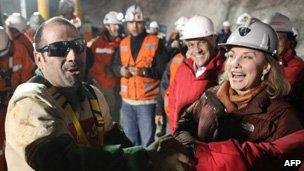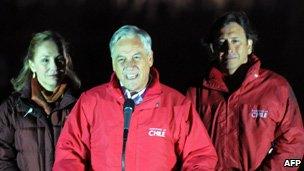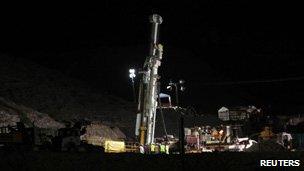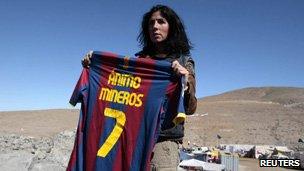Chile mine: The winners
- Published
Rescuing the 33 miners trapped underground in Chile has taken more than two months. During that time, reputations have been enhanced, new celebrities created, and global marketing opportunities exploited.
The miners

Mario Sepulveda (L) is already something of a celebrity in Chile
Their ordeal is likely, ultimately, to prove lucrative. The life stories of the 33 miners - 32 Chileans and one Bolivian - have become widely known during their time underground. Most will receive lucrative offers for TV appearances; perhaps films and books will be in the offing.
They have reportedly agreed not to speak to the media about their experiences initially, and have asked a lawyer to draw up a contract to split equally all profits from their experiences.
People involved in the rescue attempt believe Mario Sepulveda, the telegenic spokesman for the group, will be a star. He managed to compile video diaries of life underground that have been shown around the world. "I think I had extraordinary luck. I was with God and with the devil. And I reached out for God," he said after he was freed.
If they fail to become media stars, they need not worry because the Associated Press reported in mid-September, external that more than 20 firms have made them more than 1,000 job offers - including bulldozer drivers, mechanics, electricians and "risk reduction specialists".
More generally, union leaders hope the accident will help boost the image of miners in Chile. Analysts say miners were increasingly considered to be privileged, with high wages and hefty bonuses.
The politicians

Sebastian Pinera (C) is president, but Laurence Golborne (R) has higher ratings
In January this year, a right-wing government was elected in Chile for the first time. Billionaire President Sebastian Pinera, external has been determined to portray himself as a man of the people - and the mining disaster has afforded him the opportunity. He was at the mine on 23 August to announce that the men were still alive, telling TV cameras: "It will take months to get them out. It will take time, but it doesn't matter how long it takes to have a happy ending."
He has been a constant presence, and was on hand at the final rescue, proclaiming the operation a "miracle". His approval ratings have soared above 70%.
But the president has been outshone by Laurence Golborne, his equally ubiquitous mining minister. Mr Golborne has been at the mine almost constantly since August, briefing journalists with equal affability in Spanish and English. His approval ratings are said to be about 85%. His twitter feed , externalhas added 15,000 followers in the past week. Some commentators have already labelled him the most popular man in Chile.
With Health Minister Jaime Manalich giving regular efficient briefings on the condition of the miners, and down-to-earth engineer Andre Sougarret updating the media on the drilling operation, the government has managed to present itself as competent, charismatic and sympathetic. It seems many people in Chile have been won over.
The companies

The Schramm T-130 is used in undersea oil drilling, but outperformed the other machines
Schramm Inc describes itself as a "century-old Chester County, Pennsylvania manufacturer and global supplier to the hydraulic drilling industry". The firm can have had few better publicity campaigns than the Chile mine rescue. Their machine - the Schramm T-130 machine, known as Plan B - was the second of three machines assembled at the site, but it proved more effective than the other two drills. The T-130 eventually bored the rescue shaft that was used in the rescue.
State-run mining firm Codelco, the world's top copper producer, also played a major part in the rescue. Analysts say it showed expertise and resourcefulness during the crisis.
Away from mining, California-based sunglasses firm Oakley made headlines worldwide by supplying its products to the workers as they emerged from the rescue shaft. Media around the world informed us that each man would be provided with a $450 (£284) pair of glasses.
The organisations

Barcelona star David Villa signed two shirts for the miners
Football clubs are among the most prominent groups keen to send their support. Real Madrid sent signed shirts and invited the miners to a game in the Spanish capital. Manchester United reportedly made a similar offer. They were both following the example of Barcelona striker David Villa, who got in early by donating a signed shirt to the miners. Villa's father and grandfather were both miners.
Nasa sent a group of experts to help the rescue team, external advise the miners on diet and the psychological effects of spending long periods of time in isolation.
Finally, the saturation coverage of the drama by news organisations is likely to have boosted business for media groups around the world.